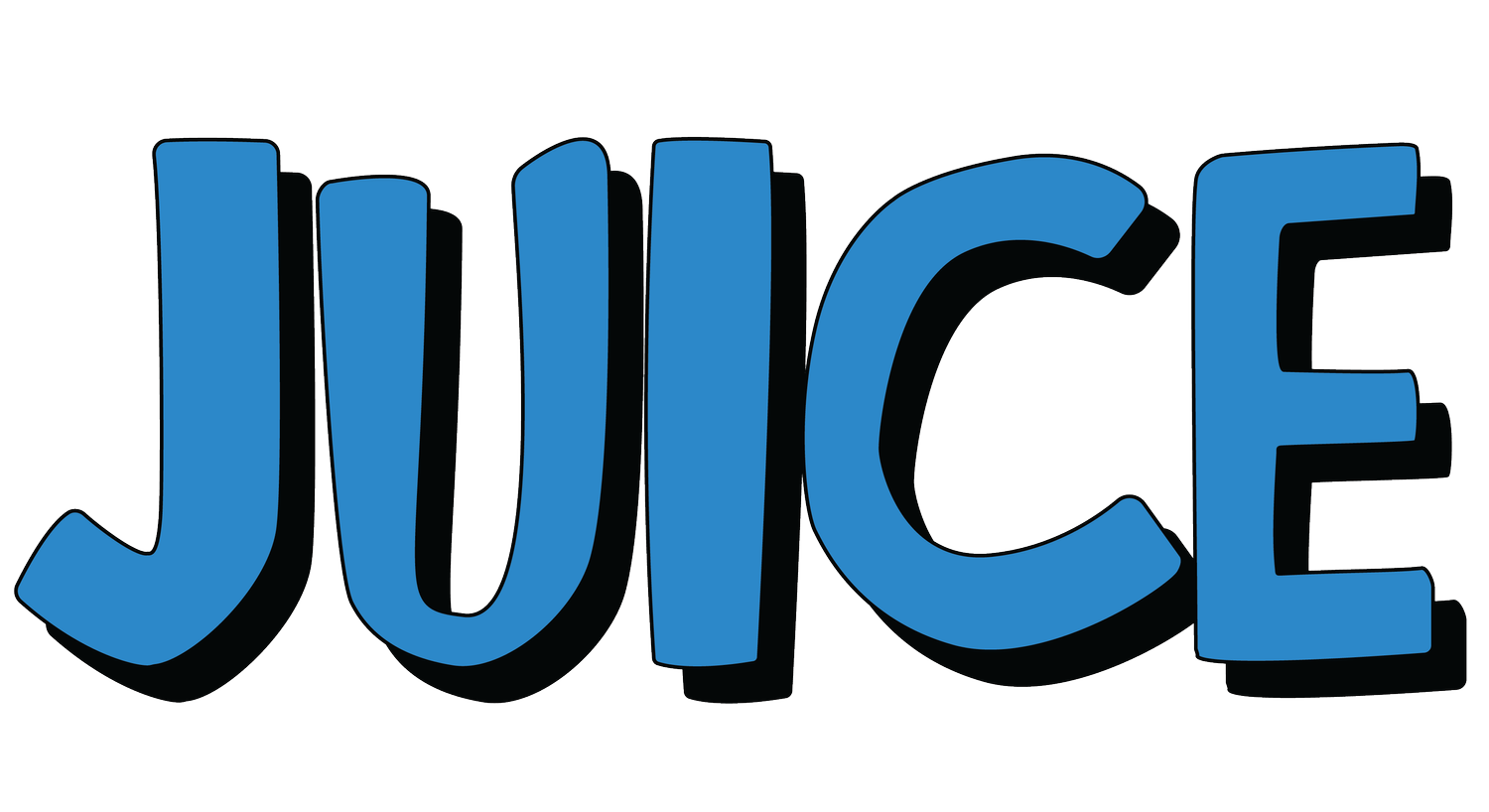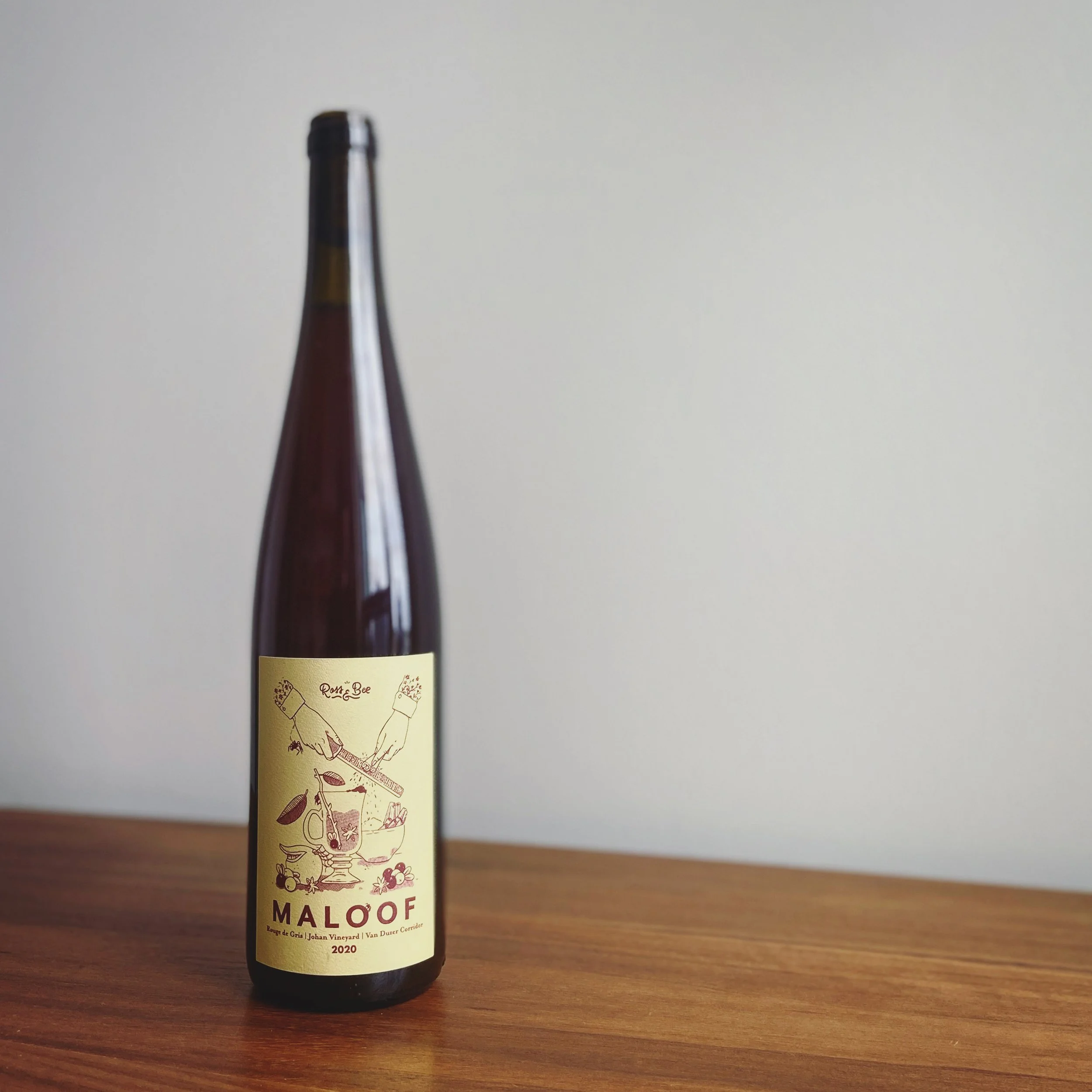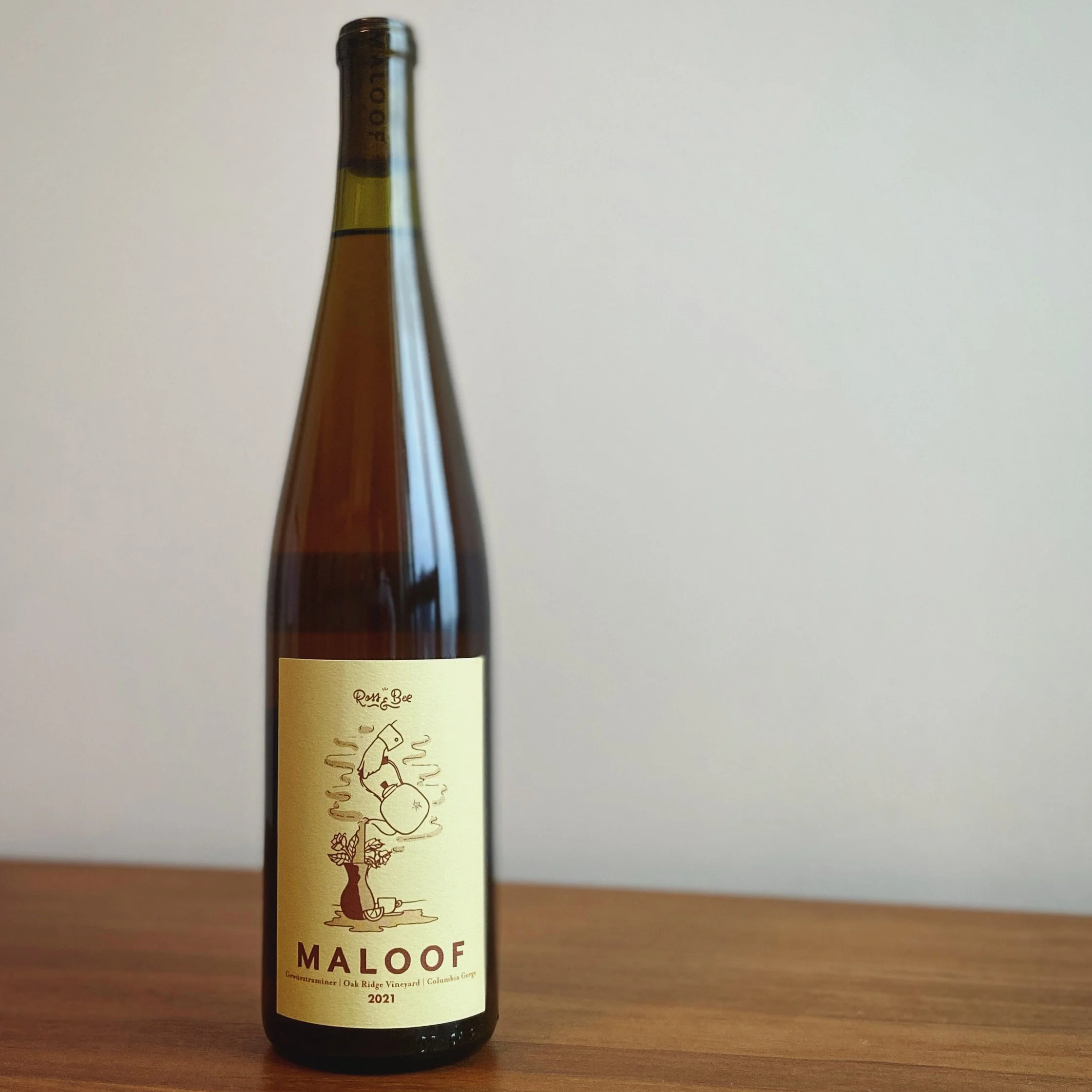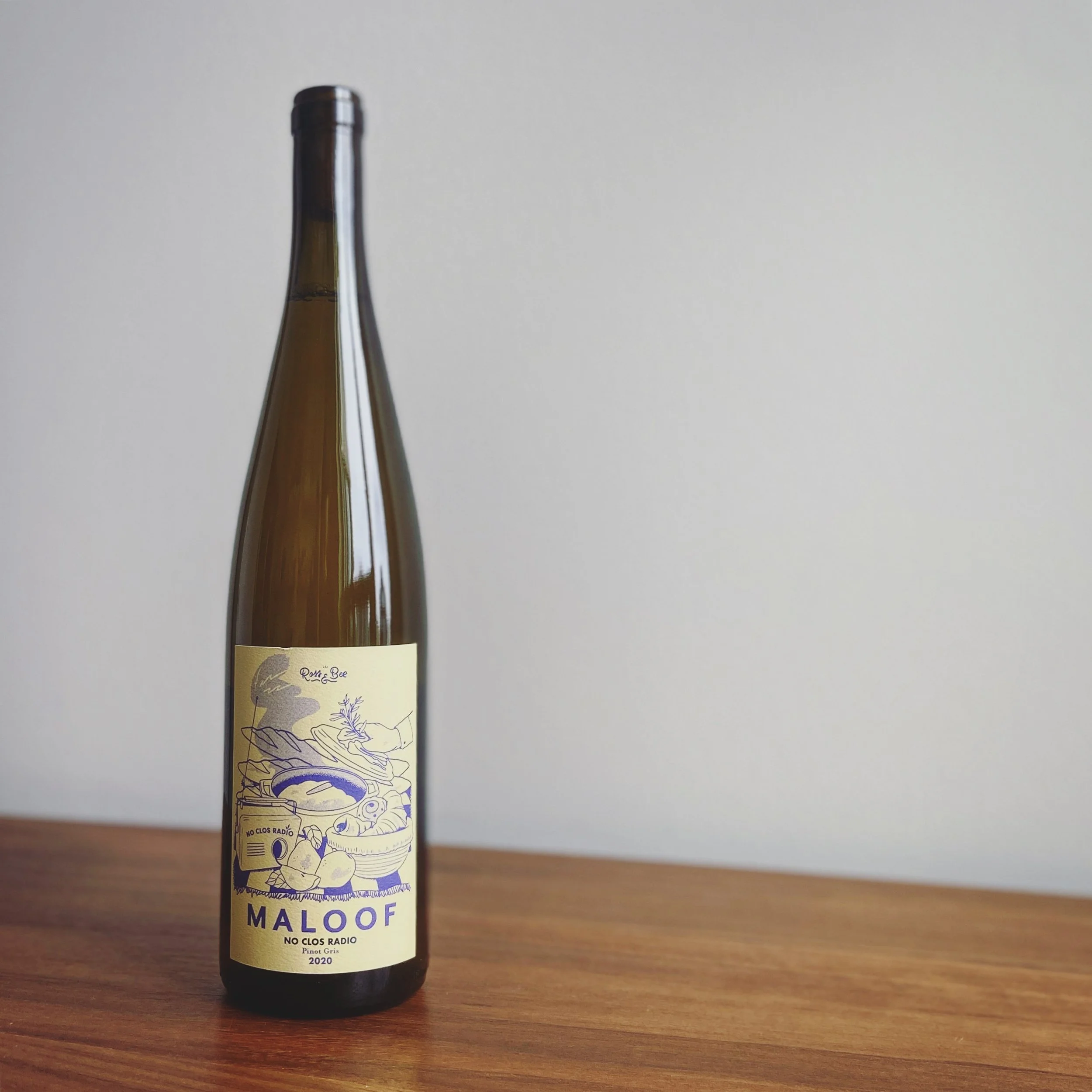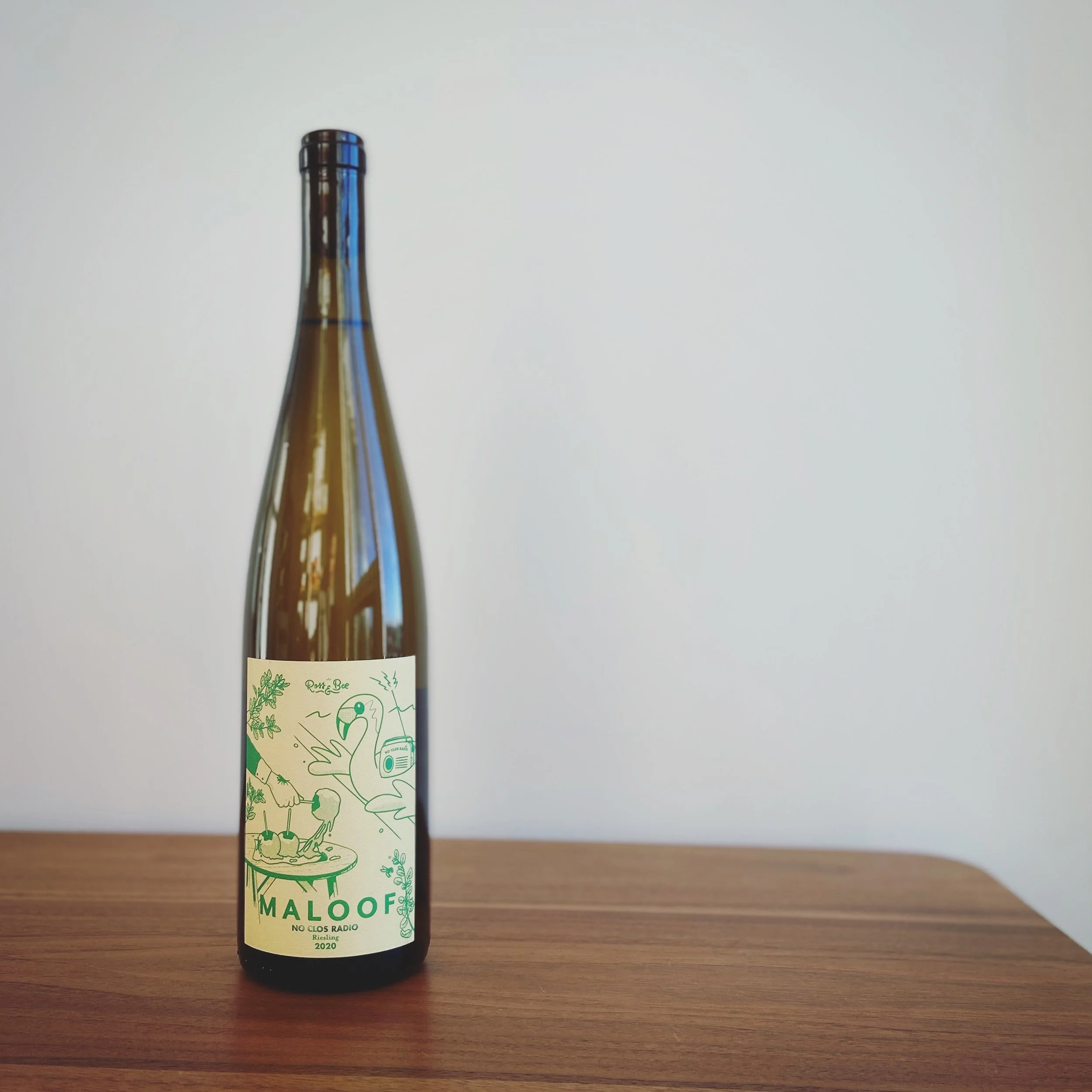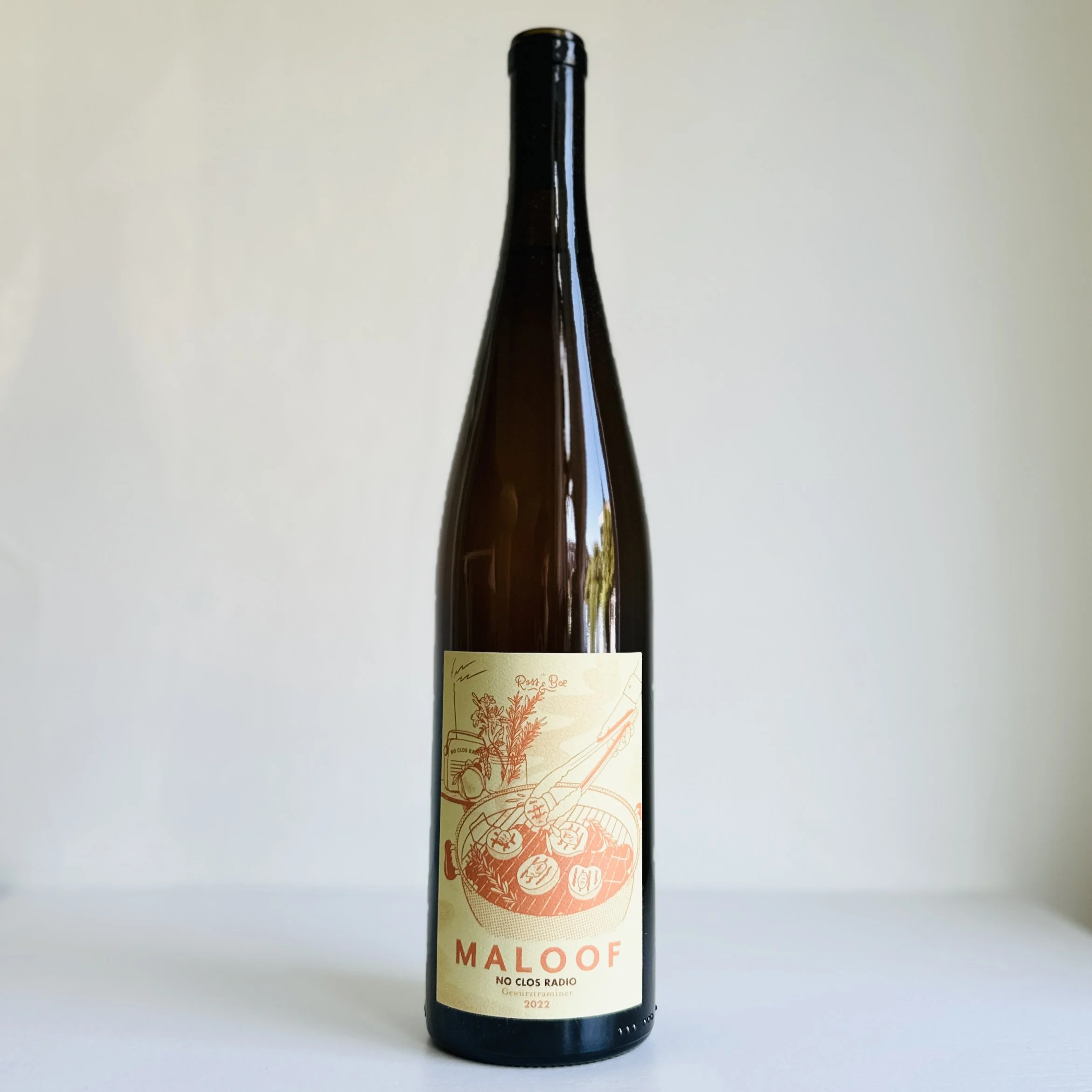MALOOF
-
Ross & Bee Maloof, the couple behind their eponymous winery, are originally from Philadelphia. In a virtual interview we did with Ross, he proceeded to chastise us for scheduling work during a hockey game, and by the reflection in his glasses, we could tell he was watching the Flyers on mute. He spent a decade working in the dining scene while Bee pursued a career as a materials engineer for the aerospace industry – I can only assume she was designing super suits for NASA.
They moved out west to get closer to the vines that produced the wines they loved. After interning, they began their project in earnest in 2015. They immediately started pairing up with farmers who shared their philosophy: certified organics, sustainable practices, dry farming, own-rooted vines, and a quest for both quality and transparency of terroir. Their connection to these collaborators is strong; their vintage reports always include in-depth accounts of the farmers' connection to the land. This reverence can be felt in the wines – a duty to accurately share their stories.
-
Pinot Gris plays a central role in their winemaking story. It is genetically identical to Pinot Noir, has been planted in Oregon since the 60s, and is celebrated in regions like Alsace, yet the examples coming out of the Willamette Valley were almost universally flavourless, dull, and simple. Their quest has been to highlight this grape's underreported ability to capture time and place with its plethora of spice and unique texture. By strictly controlling yields, opting for premium sites, harvesting when appropriately ripe, exploiting skin contact, and allowing for longer élevage times, they hope to get this cultivar the praise it deserves. They are so confident in their mission that they've even offered Pinot Noir prices for Pinot Gris if growers agree not to rip up the vines – the stigma against this grape has led to the uprooting of an absurd amount of quality acreage, only to be replanted with more fashionable varieties.
-
In 2020, with the help of their partners in crime, Jim & Jenny of Fossil & Fawn, they were able to purchase their own 27-acre vineyard just west of Portland in the Tualatin Hills. They immediately began converting to organic farming and will receive certification in 2022. When we first met Ross & Bee, they didn't seem quite sure they'd end up on the farming side of the wine equation, but over the last couple of years, we've seen them dive into it head first, revelling in the manual labour. These 50-year-old vines, surrounded by forest high in the Oregon coastal range, will produce some of the most thrilling wines in the state.
Ross and Bee are amongst the most charming, sporadic, eccentric people we've ever met. Their punk-rock energy and scientific precision make them the ideal team. We can't wait to drink these wines for decades to come.
GROWN AND MADE ON THE TRADITIONAL LANDS OF THE: CONFEDERATED TRIBES OF GRAND RONDE | CONFEDERATED TRIBES OF SILETZ INDIANS | LUCKIAMUTE | YAMHILL | KALAPUYA | ATFALATI | TAKELMA | TOLOWA DEE-NI’ | COW CREEK UMPQUA | MODOC
2022 WHERE YA PJS AT?
Four sites were used for this cuvée: No Clos Radio (own-rooted in Tualatin Hills), Logsdon Ridge (own-rooted near Corvalis), Resplendor Vineyard (Yamhill-Carlton), and Ony’s Parcels (own-rooted in someone’s backyard) Each site is incredibly unique, but the farming is unanimously organic and unirrigated. This wine is made from Pinot Gris (75%), most of which was fermented on skins (open top and carbonic for 20 days), but some were directly pressed into barrels. The remainder is direct pressed Riesling (5%), Chardonnay (5%), Muller-Thurgau (5%), Cabernet Sauvignon (5%), and a undisclosed field-blend (5%). After the wine is blended, 30ppm of SO2 is added.
2022 L’EAU EPICEE
The fruit for this cuvée comes from an unnamed vineyard behind a house in Sherwood, Oregon. This plot in the Chehalem Mountains was planted in the 90s on classic Jory soils. Onesimo Mora farms this own-rooted site using organic practices and without irrigation. Riesling (70%) and Gewürztraminer (30%) were direct pressed into stainless steel tank for fermentation, although one third of the latter was fermented on skins for extra texture and aromatic intensity. Once the wine was fully dry, it was racked into barrel, where Ross & Bee added a small amount of freshly thawed, unfermented Riesling juice collected at pressing. The wine is then bottled and allowed to undergo secondary fermentation in bottle over the winter/spring. Two hundred fifty cases were produced.
2022 THISTLE PINOT GRIS
Haaken Lenai Vineyard (originally Thistle Vineyard) was planted in 2000 by Jon & Laura Jennison. Last year it was purchased by Cody Wright, who continues to lease the only two blocks of Pinot Gris to Ross & Bee. The vineyard sits at 700 feet above sea level in the Dundee Hills AVA. Soils here are classic Jory. The grapes were direct pressed into neutral barrel for both fermentation and élevage. After nine months on lees without bâtonnage, the wine is racked and bottled unfined, unfiltered, and with 30ppm of SO2. 472 cases were produced.
2023 WAX ON WAX SOIF ROUGE
Ron & Laurie Burley planted this site in the Applegate Valley in 1993. Much cooler than most of the region this site sits near the river on a combination of granite and alluvial deposits. This organic vineyard is consistently Ross & Bee’s last pick each vintage. The wine is made from Syrah (30%), Grenache (40%), and Viognier (30%) co-fermented on skins for seven days. The wine is pressed off into neutral barrel for élevage. It is then racked and bottled unfined, unfiltered, with 30ppm of SO2.
2021 JOHAN ROUGE DE GRIS
Johan Vineyard is planted in the cool Van Duzer Corridor Sub-AVA of the Willamette Valley. Achieving Demeter Biodynamic certification in 2010, this site features marine sediment and granite. The Pinot Gris grapes were treated as you would Pinot Noir. 85% was destemmed and fermented on skins for 33 days with quotidien punch downs to ensure the cap stays moist. 15% was fermented carbonically. Élevage was completed in neutral barrels before bottling unfined and unfiltered eight months later. 512 cases were produced.
2022 OAK RIDGE GEWURZTRAMINER
Marlene and Thomas Woodward’s site sits at 1400 feet above sea level in the White Salmon Valley, part of the Columbia Gorge AVA. The forty-year-old organic Gewurztraminer vines rest in Chemawa soils, facing south in the foothills of Mount Adams. Ross & Bee have been desperate to get their hands on this fruit again for a few years, so this cuvée feels particularly special to them. The grapes are fermented on skins for 19 days before being pressed off into neutral Burgundy barrels for an 8-month élevage. It was bottled unfined and unfiltered with 30ppm of SO2. Only 130 cases were produced.
2022 NO CLOS RADIO PINOT GRIS
This site is in the newly recognized AVA of Tualatin Hills, west of Portland. The isolated vineyard is surrounded by forest and features typical Jory and Loess, as well as pisolitic iron and manganese. It was originally planted by Harvey Shafer in the 1970s, but Ross & Bee were able to purchase the site in collaboration with their friends Jenny & Jim of Fossil & Fawn. The vines are own-rooted and dry farmed. Although the vineyard was being farmed sustainably, its new stewards are pursuing organic certification. The Pinot Gris was harvested on October 9th and direct pressed into neutral barrel for fermentation and élevage on full lees. No batonnage is done. The wine is bottled unfined, unfiltered, and with 30ppm of SO2. Only 200 cases were produced.
2022 NO CLOS RADIO RIESLING
This site is in the newly recognized AVA of Tualatin Hills, west of Portland. The isolated vineyard is surrounded by forest and features typical Jory and Loess, as well as pisolitic iron and manganese. It was originally planted by Harvey Shafer in the 1970’s, but Ross & Bee were able to purchase the site in collaboration with their friends Jenny & Jim of Fossil & Fawn. The vines are own rooted and dry farmed. Although the vineyard was being farmed sustainably, its new stewards are pursuing organic certification. The Riesling was crushed by foot before being pressed off into neutral burgundy barrels. After a short élevage, the wine is filtered and bottled with 9 g/l of residual sugar - essentially Oregon Feinherb. 50 cases were produced.
2022 NO CLOS RADIO GEWURZTRAMINER
This site is in the newly recognized AVA of Tualatin Hills, west of Portland. The isolated vineyard is surrounded by forest and features typical Jory and Loess, as well as pisolitic iron and manganese. It was originally planted by Harvey Shafer in the 1970s, but Ross & Bee were able to purchase the site in collaboration with their friends Jenny & Jim of Fossil & Fawn. The vines are own-rooted and dry-farmed. Although the vineyard was being farmed sustainably, its new stewards are pursuing organic certification. The Gewurztraminer was destemmed and fermented on skin in open-top tank until dry, 12 days. The wine is then pressed off into neutral puncheon for élevage. The wine is bottled unfined, unfiltered, and with 30ppm of SO2. 50 cases were produced.
2021 TEMPERANCE HILL PINOT GRIS
Dai Crisp has been managing this legendary vineyard for the past twenty years. Located in the coolest section of the Eola-Amity hills, this site feels the full wrath of the Van Duzer Corridor, a break in the coastal range that allows cold ocean winds into the valley. This delays afternoon ripening, increases skin thickness, and decreases berry size. Planted on Ritner and Nekia soils, the vines are dry farmed. Pinot Gris tends to command far lower prices than Pinot Noir, so the intention was to replant. Ross & Bee realized what a shame it would be to lose this superb fruit and offered to pay Pinot Noir prices - what seemed fool hardy at first has resulted in a new benchmark for the variety in Oregon. The grapes were harvested in two passes, one on September 28th for higher acid, and a second on October 11th for structure. The grapes were direct pressed into neutral barrels for fermentation and a ten-month élevage. It has a couple grams of R/S so 22ppm of SO2 was added after a light filtration. 265 cases made this vintage.
